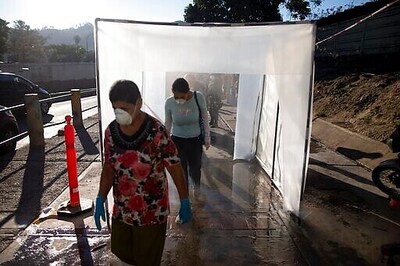
views
A big takeaway of the interim Budget is the ambitious scheme, Pradhan Mantri Kisan Samman Nidhi (PM-Kisan), which aims to placate small farmers by offering Rs 6,000 per year. But it was on the cards. However, it is uncertain how would it help farmers, who are suffering because of low income, or the government, which has rolled out the scheme with an eye on the forthcoming general election.
The good things first. The PM-Kisan is at least a palliative, albeit, a weak one. The Rs 6,000 benefit will be available to farmer families with cultivable land up to two hectares. Finance Minister Piyush Goyal said, “This income support will be transferred directly into the bank accounts of beneficiary farmers, in three equal installments of Rs 2,000 each. This programme will be funded by government of India. Around 12 crore small and marginal farmer families are expected to benefit from this.”
Further, he said, the outlay would be “of Rs 75,000 crore for the FY 2019-20 and Rs 20,000 crore in the Revised Estimates of FY 2018-19.” Which means that farmers would benefit this fiscal as well. The PM-Kisan is at least better than farm loan remissions announced by several state governments, for the waivers are morally indefensible, fiscally ruinous, and economically untenable.
On animal husbandry, the Finance Minister said, “I have increased the allocation for Rashtriya Gokul Mission to Rs 750 crore in the current year itself. I announce setting up of Rashtriya Kamdhenu Aayog to upscale sustainable genetic upgradation of cow resources and to enhance production and productivity of cows.” This is likely to make several supporters of his party happy, though what the Aayog does for cows is to be seen.
He also announced the decision to create a separate Department of Fisheries.
More substantively, Goyal announced 2 percent interest subvention to the farmers pursuing the activities of animal husbandry and fisheries, who avail loan through Kisan Credit Card. Further, in case of timely repayment of loan, they will also get an additional 3 per cent interest subvention.
Now, the not-so-good aspects of Budget provisions. First, a family can’t improve its lot substantively with an additional annual income support of Rs 6,000. Second, palliatives don’t cure. The cure is opening up of the farm sector.
Sadly, there is nothing in the Budget that the government even desires to introduce liberalising measures. At least, it doesn’t appear in the ‘Vision for the next Decade’ that he announced.
He did say, “Making India self-sufficient in food, exporting to the world to meet their food needs and producing food in the most organic way is the Eighth Dimension of our Vision. High farm production and productivity will be achieved through modern agricultural practices and value addition. An integrated approach towards agro and food processing, preservation, packaging and maintenance of the cold chain will be our focus of attention.”
But such terms as ‘reforms’, ‘liberalization’, and ‘structural changes’ don’t appear anywhere while he was discussing agriculture. This is despite the fact that liberalization is urgently needed in the farm sector. Arvind Panagariya, a prominent economist who was chosen by Prime Minister Narendra Modi to head the Niti Aayog, had emphasised this in a 2014 lecture.
He had said, “To ensure that farmers get a larger share in the price of the produce paid by the consumer, the next government must complete the reform of the Agricultural Produce Marketing Committees Act in all areas, for all crops, and in all states. This requires giving greater play to the right to directly purchase and sell, facilitating the emergence of competing private marketing yards, expansion of contract farming, provision of cold storage facilities and the building of supply chains.” None of this appears in the interim Budget.
Panagariya favored the abolition of minimum support prices (MSPs). He said, “It is also worth considering replacing the minimum support price, and its associated procurement, by the equivalent of deficiency payments in the United States.”
The government actually did the opposite. As Goyal said in the Budget speech, “With an aim to double the income of farmers, our government, for the first time in history has fixed the minimum support price of all 22 crops at minimum 50 per cent more than the cost.”
While Panagariya and other economists advocate reform Agricultural Produce Marketing Committees (APMCs), the bane of farmers, the interim Budget doesn’t even mention the term APMCs, let alone talk about revamping them.
In October 2016, the Prime Minister-headed Niti Aayog had suggested three main reforms: in agricultural markets, land leases, and those related to forestry on private land (that is, felling and transit of trees).
The Aayog went on to point out that “agricultural development in India has entirely ignored the potential of marketing and has continued to follow its old trajectory. Therefore, the benefits that can be accrued from agriculture are largely untapped.” Again, there was nothing in the interim Budget to further the Aayog agenda.
In a nutshell, therefore, there is little in the interim Budget that can meaningfully help farmers. At best, the PM-Kisan is a weak balm and, thus, not the proper therapy. But could the government hope to win over the farmer with these measures? We’ll know in May.
(Writer is a senior journalist. Views are personal.)




















Comments
0 comment